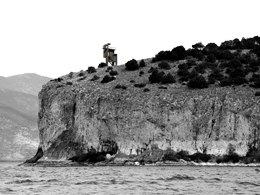STUDENTS PROJECTS
PROJECTS2013

08 June, 2015
Three countries. Two lakes. One journey
Interventions around the tripoint.
Student: Bourdi Maria
Tutor: Panos Dragonas
University of Patras_ Department of Architecture
Presentation date: February 2014
The region of Prespa consists of two lakes, which are shared by three countries: Greece, Albania and FYROM. Starting a parallel journey through time and space, this design thesis attempts to define the identity of a place in constant transition. Deconstructing its long history, five time moments are selected. These moments define an imaginary journey throughout time and lead to the selection of seven points of intervention in space.

Moment 01 | The beginnings. The genesis of the landscape .
According to the area' s myth, the lakes were created during one night when Prespa and her beloved ones, the children of the Lords of the two hostile tribes that lived in the area, decided to open the water sources and destroy the valley that separated the two tribes. In each side, a hydrogenerator is created near the sources of the rivers that flow into the lakes. The force of the water moves a mechanism and supplies a spotlight that creates a constant beam of light. Two vertical traces of light, like beacons, consist of the only visible elements of the landscape at night, reviving the myth. The water's force gives birth to the landscape and the narrative begins with the light.

Moment 02 | Prespa as the heart of the Balkans.
In 986 a.C. the island of Aghios Achilleios that is located in the Small Prespa Lake, became the capital of a kingdom that expanded throughout the Balkan peninsula. The only trace of this period is the old basilica of Aghios Achilleios. In order to emphasize the monument that is conceived as a transverse line on the landscape, a wooden corridor is designed that climbs on the hill and leads to a balcony on top.

Moment 03 | Prespa as a shelter.
Isolated and with no economic interest under the Ottoman rule, Prespa was not that important to the conquerors. Many monks and eremites inhabited the area. The vertical rocks in the west side of the Great Prespa Lake were converted into hermitages. In Golem Grad island, at the closest point near the Tripoint, small caves are carved to create shelters for the modern travellers of Prespa.

Moment 04 | The borders
FYROM |Otesevo, a lakeside village, was depopulated after Yugoslavia's collapse. Nowadays, it is a ghost tourist resort. The ground floor of the abandoned hotel Evropa is the point of intervention in the FYROM part. The once solid slab of the floor is gradually crumbling. Between the gaps and the solid surfaces, the visitor may follow a specific path. At the end of the path, a little wooden corridor bridges the gaps.

Albania | At the time that Albania was isolated from the rest of the world, 750,000 bunkers were built. In the lakeside village Zaroshke, there is an abandoned military area. A wooden ramp sinks into the ground, leading to the entrance of the big central bunker. The internal floor is totally destroyed. A wooden corridor leads to the only window that overlooks the projection of an imaginary enemy.

Greece | The most important period for the Greek part of Prespa was the Civil war. The last battle of the war took place at the narrow zone that separates the two lakes. The victims of airplane attacks, were trapped in this specific spot. In Daseri, one of the villages that were abandoned after war, the only remnants of the whole settlement are the four stonewalls of the school. A wooden ramp sinks into the ground creating a spiral movement. The ramp starts from the perimeter and ends at the center of the ruin. At the end of the route there is a water surface. The reflection of the sky on the water intensifies the vertical axis and turns the visitor's gaze towards the sky. In this way, a dead end between water and sky is created.

Moment 05 | Nowadays. The era of transborder cooperation.
During the last years, Prespa's people have decided to collaborate and bring nature to the front line. Three observatories are placed at the closest points of land that surround the tripoint. Although there are no walls in their perimeter, the view is directed by these structures. A balcony allows the simultaneous view of the other two countries for the first time. The three objects form a triangle. The observation of nature takes place along the observation of the "others". The borders are still there, but they have lost their strength.












